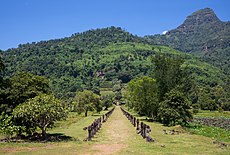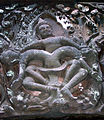Category:Wat Phou
Hindu temples complex and ruins in Laos (UNESCO site) | |||||
| Upload media | |||||
| Instance of |
| ||||
|---|---|---|---|---|---|
| Part of | |||||
| Location | Champasak, Champasak Province, Laos | ||||
| Located in or next to body of water | |||||
| Heritage designation |
| ||||
| Religion or worldview | |||||
| official website | |||||
 | |||||
| |||||
The Wat Phou site, also referred to as Vat Phou or Vat Phu or Kurukshetra, is a UNESCO world heritage site located on the right bank of Mekong river in Champasak Province of southern Laos. It stretches from the river bank to a lush mountain unusually shaped like a Shiva linga and called Lingaparvata in ancient times. It was considered sacred by the Khmer people and their kings. From the hills flow a permanent sacred spring, near which the Khmer built a sacred city stretching from the hills to the Mekong river.
The Wat Phou site contains
- the oldest known Sanskrit inscription in southeast Asia (c. 450 CE) – called the Champassak Inscription of Devanika,
- some of the early Tamil inscriptions in southeast Asia (6th to 7th century),
- some of the earliest known Shiva, Vishnu and Durga (pre-Angkor) Hindu artwork along the Mekong river, and
- numerous ruins of ancient to medieval Hindu temples.
The oldest layer of artwork and temple remains are from the 5th century, other smaller temples from 6th to 10th centuries. Most of the large mandapa and temple ruins that survive at Wat Phou date between the 10th and 14th century.
The site was rediscovered and details about it published during the colonial era by the French with the help of local villagers. The buildings were reclaimed by the Buddhists, and some buildings now feature a Buddha statue along with some other Buddhist iconography. The extant site attracts Buddhist devotees as well as hosts annual Buddhist festivals.
Along with temples, the Wat Phou heritage site has many mounds. Some of these have been excavated by Japanese, Italian and French teams. These have confirmed the existence of nearly 3 mile (5 kilometer) stretch of Hindu and Buddhist temples midst an ancient city. Many inscriptions have been found, some of which call this site as the Kurukshetra tirtha – mirroring the Indian mythistory of the Mahabharata.
Media in category "Wat Phou"
The following 124 files are in this category, out of 124 total.
-
Buddha - Vat Phu.JPG 5,184 × 3,456; 5.37 MB
-
Buddhist child monk in Wat Phou.jpg 2,904 × 1,936; 1.8 MB
-
Causeway and Barays Wat Phu 0521.jpg 2,592 × 1,944; 4.05 MB
-
Champasak VatPhou1 tango7174.jpg 1,290 × 600; 396 KB
-
Champasak VatPhou2 tango7174.jpg 1,200 × 600; 441 KB
-
Champasak VatPhou3 tango7174.jpg 800 × 667; 398 KB
-
Champasak VatPhou4 tango7174.jpg 1,800 × 600; 688 KB
-
Champasak VatPhou5 tango7174.jpg 840 × 600; 328 KB
-
Champasak VatPhou6 tango7174.jpg 800 × 600; 303 KB
-
Champasak VatPhou7 tango7174.jpg 800 × 600; 291 KB
-
Champasak VatPhou8 tango7174.jpg 800 × 600; 355 KB
-
Champasak, Laos, Wat Poo 01.jpg 2,500 × 1,000; 1.29 MB
-
Champasak, Laos, Wat Poo 02.jpg 2,500 × 1,000; 1.49 MB
-
Champasak, Laos, Wat Poo 03.jpg 2,500 × 1,000; 1.39 MB
-
Champasak, Laos, Wat Poo 04.JPG 2,500 × 1,250; 1.41 MB
-
Champasak, Laos, Wat Poo 05.JPG 2,500 × 1,250; 1.57 MB
-
Champasak, Laos, Wat Poo 06.JPG 2,500 × 1,667; 2.22 MB
-
Champasak, Laos, Wat Poo 07.JPG 2,500 × 1,667; 2.41 MB
-
Champasak, Laos, Wat Poo 08.JPG 1,667 × 2,500; 2.51 MB
-
Champasak, Laos, Wat Poo 20.JPG 1,667 × 2,500; 1.71 MB
-
Champasak, Laos, Wat Poo 21.JPG 2,500 × 1,667; 1.59 MB
-
Champasak, Laos, Wat Poo 22.JPG 2,500 × 1,667; 2.02 MB
-
Champasak, Laos, Wat Poo 23.JPG 2,500 × 1,667; 2.08 MB
-
Champasak, Laos, Wat Poo 25.JPG 2,500 × 1,667; 1.59 MB
-
Champasak, Laos, Wat Poo 26.JPG 2,500 × 1,667; 2.06 MB
-
Champasak, Laos, Wat Poo 27.JPG 1,667 × 2,500; 1.69 MB
-
Champasak, Laos, Wat Poo 28.JPG 2,500 × 1,667; 1.8 MB
-
Champasak, Laos, Wat Poo 31.JPG 2,500 × 1,667; 1.67 MB
-
Champasak, Laos, Wat Poo 32.JPG 2,500 × 1,667; 1.5 MB
-
Champasak, Laos, Wat Poo 33.JPG 2,500 × 1,667; 1.57 MB
-
Champasak, Laos, Wat Poo 34.JPG 2,500 × 1,500; 1.4 MB
-
Champasak, Laos, Wat Poo 35.JPG 1,667 × 2,500; 2.29 MB
-
Champasak, Laos, Wat Poo 36.JPG 1,667 × 2,500; 1.88 MB
-
Champasak, Laos, Wat Poo 37.JPG 1,667 × 2,500; 1.88 MB
-
Champasak, Laos, Wat Poo 38.JPG 1,667 × 2,500; 2.03 MB
-
Champasak, Laos, Wat Poo 39.JPG 1,667 × 2,500; 2.04 MB
-
Champasak, Laos, Wat Poo 40.JPG 1,667 × 2,500; 2.05 MB
-
Champasak, Laos, Wat Poo 41.JPG 2,500 × 1,667; 2.29 MB
-
Champasak, Laos, Wat Poo 42.JPG 1,667 × 2,500; 1.87 MB
-
Champassak, Site de Vat Phou palais des Femmes (2).jpg 4,912 × 3,264; 11.8 MB
-
Champassak, Site de Vat Phou palais des Femmes .jpg 4,912 × 3,264; 9.44 MB
-
Champassak, Site de Vat Phou relief au palais des Femmes .jpg 4,360 × 2,367; 2.79 MB
-
Champassak, Site de Vat Phou Trimurti.jpg 4,448 × 3,125; 4.56 MB
-
Champassak, Site de Vat Phou.- Causeway and Barays.jpg 4,912 × 3,264; 7.06 MB
-
Champassak, Vat Phu (2).jpg 6,711 × 1,768; 10.37 MB
-
Champassak, Vat Phu.jpg 4,912 × 3,264; 3.7 MB
-
Champassak.- Panorama of Vat Phou (2).jpg 4,912 × 3,264; 5.72 MB
-
Champassak.- Panorama of Vat Phou (3).jpg 3,824 × 2,869; 2.91 MB
-
Champassak.- Panorama of Vat Phou .jpg 4,912 × 3,264; 7.28 MB
-
Champassak.- Vat Phou Portrait au temple de la montagne.jpg 2,228 × 2,534; 3.07 MB
-
Champassak.- Vat Phou statue 2 du temple de la montagne.jpg 3,264 × 4,912; 7.71 MB
-
Champassak.- Vat Phou statue du temple de la montagne.jpg 3,264 × 4,912; 8.84 MB
-
Cliff Face - Wat Phu Champasak - Laos.JPG 2,304 × 3,072; 3.12 MB
-
Cliff Face at Wat Phu Champasak - Human for Scale.JPG 2,304 × 3,072; 3.06 MB
-
Countryside around Wat Phu Champasak - Laos.JPG 3,072 × 2,304; 3.09 MB
-
Crocodile Outline Wat Phu 0522.jpg 1,944 × 2,592; 3.76 MB
-
Devata Wat Phu 0515.jpg 1,232 × 2,489; 2.58 MB
-
Krishna Kills Kamsa Wat Phu 0518.jpg 1,163 × 1,342; 1.64 MB
-
Le « temple de la montagne »Site de Vat Phou Champassak, Laos (1).jpg 4,777 × 2,728; 2.86 MB
-
Le « temple de la montagne »Site de Vat Phou Champassak, Laos (2).jpg 4,912 × 3,264; 6.88 MB
-
Linga Parvata Laos 0502.jpg 1,558 × 999; 1.02 MB
-
Lower Terrace Wat Phu 0509.jpg 2,592 × 1,944; 2.19 MB
-
Monk - Vat Phu baray.JPG 5,184 × 3,456; 3.8 MB
-
Offrande sur le site de Vat Phou.-Champassak, Laos.jpg 2,381 × 3,516; 4.39 MB
-
Pediment showing Krishna killing Kamsa, south side of sanctuary at Wat Phou, Laos.jpg 2,560 × 1,920; 766 KB
-
Sanctuary Wat Phu 0517.jpg 2,592 × 1,944; 3.93 MB
-
Trimurti - Vat Phu.JPG 5,184 × 3,456; 12.28 MB
-
Trimurti Wat Phu 0519.jpg 2,295 × 1,935; 4.7 MB
-
Vat Phu -Laos 01-2014 (1).jpg 3,264 × 4,912; 4.13 MB
-
Vat Phu -Laos 01-2014 (2).jpg 4,448 × 3,318; 1.93 MB
-
Vat Phu -Laos 01-2014 (3).jpg 1,727 × 1,711; 676 KB
-
Vat Phu -Laos 01-2014 (6).jpg 4,912 × 3,264; 7.03 MB
-
Vat Phu -Laos 01-2014 (7).jpg 3,264 × 4,912; 5.69 MB
-
Vat Phu -Laos 01-2014 (8).jpg 3,264 × 4,912; 6.59 MB
-
Vat Phu -Laos 01-2014 (9).jpg 3,264 × 4,912; 5.59 MB
-
Vat Phu -Laos 2014 (10).jpg 3,264 × 4,912; 6 MB
-
Vat Phu -Laos 2014 (11).jpg 4,912 × 3,264; 7.09 MB
-
Vat Phu -Laos 2014 (12).jpg 4,912 × 3,264; 6.41 MB
-
Vat Phu -Laos 2014 (13).jpg 4,912 × 3,264; 6.66 MB
-
Vat Phu -Laos 2014 (14).jpg 4,912 × 3,264; 7.09 MB
-
Vat Phu -Laos 2014 (16).jpg 3,264 × 4,912; 6.56 MB
-
Vat Phu -Laos 2014 (17).jpg 3,264 × 4,912; 7.13 MB
-
Vat Phu -Laos 2014 (18).jpg 4,912 × 3,264; 4.75 MB
-
Vat Phu -Laos 2014 (19).jpg 4,912 × 3,264; 5.13 MB
-
Vat Phu -Laos 2014 (2).jpg 4,912 × 3,264; 7.78 MB
-
Vat Phu -Laos 2014 (6).jpg 4,912 × 3,264; 6.53 MB
-
Vat Phu -Laos 2014 (7).jpg 4,912 × 3,264; 6.5 MB
-
Vat Phu -Laos 2014 (8).jpg 4,912 × 3,264; 7.22 MB
-
Vat Phu -Laos 2014 (9).jpg 2,385 × 3,666; 6.58 MB
-
Vat Phu.jpg 2,112 × 2,816; 2.26 MB
-
VatPhou2003-1.jpg 1,280 × 960; 602 KB
-
VatPhou2003-Apsara.jpg 480 × 640; 212 KB
-
VatPhou2003-Outs.jpg 1,280 × 960; 578 KB
-
ViewFromWatPhu.JPG 4,272 × 2,848; 6.79 MB
-
Vishnu on Garuda Wat Phu 0514.jpg 2,387 × 950; 2.25 MB
-
Wat Phou - Elephant.JPG 5,184 × 3,456; 8.97 MB
-
Wat Phou South side.jpg 2,288 × 1,712; 1.15 MB
-
Wat Phu 2.JPG 448 × 336; 81 KB
-
Wat Phu Champasak - Laos - 01.JPG 3,072 × 2,304; 3.02 MB
-
Wat Phu near Champasak (12847019795).jpg 3,968 × 2,648; 5.91 MB
-
Wat Phu steps (12847102523).jpg 3,968 × 2,648; 4.32 MB
-
Wat Phu.jpg 2,112 × 2,816; 2.51 MB
-
Watphoupeaklinga03.jpg 228 × 335; 5 KB
-
Watphouplan-HE.png 869 × 390; 23 KB
-
Watphouplan01.png 869 × 390; 9 KB
-
WatPhouwholesite.jpg 1,273 × 654; 109 KB
-
Watphu1.JPG 1,600 × 1,200; 255 KB
-
WatPhuCrocodile.JPG 4,272 × 2,848; 7.15 MB
-
Wpfacade02a.jpg 2,368 × 1,636; 909 KB
-
Wpvishnuongaruda01.jpg 2,541 × 1,205; 614 KB





















































































































